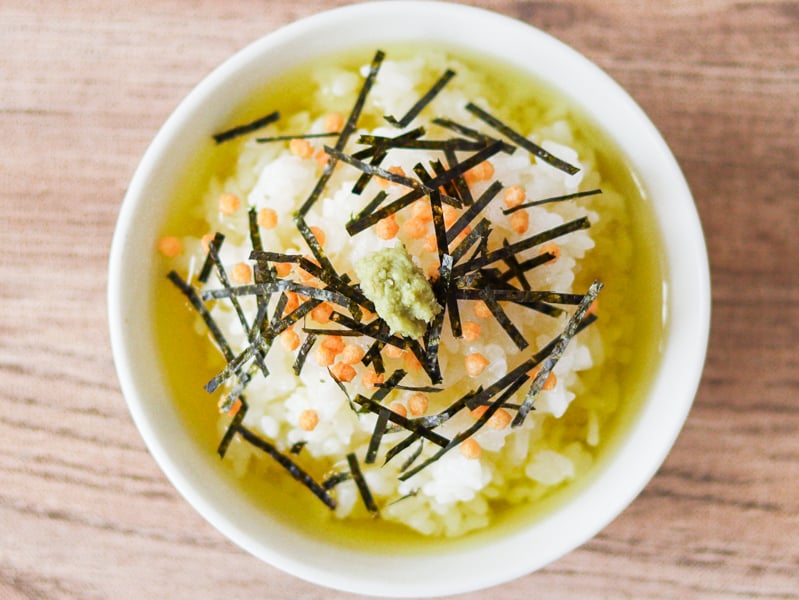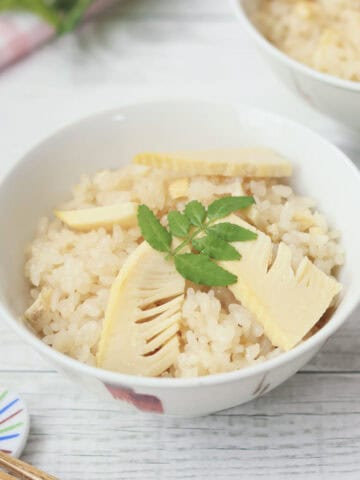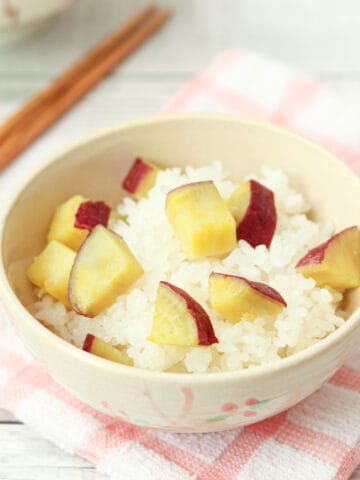Ochazuke is a traditional and popular way to enjoy rice in Japan. The flavor and color of Japanese tea embody the essence of Japan, making it an appetizing dish.

Jump to:
What is Ochazuke?
Ochazuke is a dish made by pouring a flavorful liquid over rice, such as Japanese tea or dashi broth. "Ocha" means Japanese tea, and "zuke" refers to soaking, so this dish is called 'ochazuke' because the rice is soaked in tea or liquid. Typically, a warm liquid is used, which helps warm the body.
For Japanese people who drink tea daily and always have it on hand, this dish can be a very quick and easy meal to prepare. It is often enjoyed when there are no side dishes to accompany the rice, or when one simply wants to enjoy rice on its own. I encourage you to give it a try and experience the full flavor of Japan.
Is Japanese tea necessary?
Although the name might suggest otherwise, this dish can also be made without using Japanese tea (ocha). This recipe uses sencha tea leaves (green tea leaves), but in Japan, ochazuke using dashi broth is just as common. Ochazuke made with dashi is also known as "Dashi Chazuke."
The recipe using Japanese tea is easy to prepare, while the one made with dashi is more authentic. Both versions offer distinct flavors, so I recommend trying them both.
Type of tea used
When preparing ochazuke with Japanese tea, it is customary to use sencha (green tea), hojicha (roasted green tea), or genmaicha (brown rice tea). Although you can use other types of tea, it is best to choose one that is not too strong in flavor so that you can fully enjoy the taste of the rice while complementing the tea's flavor.
If you want to enjoy this dish with a vibrant green appearance, I recommend using sencha. For a lighter flavor, hojicha or genmaicha are great choices.
Toppings and variations
Ochazuke is commonly topped with ingredients such as bubu arare (tiny Japanese rice crackers), shredded nori seaweed, toasted sesame seeds, mitsuba (Japanese parsley), and shiso leaves (perilla). Wasabi is also often added as a condiment. Additionally, it is also common to add salmon to make "Salmon Chazuke" or umeboshi (salt-pickled plums) to make "Ume Chazuke."
However, these toppings are used to enhance the flavor and texture, so if you want to make ochazuke simply, you don't necessarily need to add them. Feel free to experiment according to your preference.

Ingredients
- 5.6 oz cooked Japanese white rice
- 2 tsp sencha tea leaves (green tea leaves) (Hojicha tea leaves (roasted green tea leaves) or genmaicha tea leaves (green tea leaves blended with brown rice) can be substituted.)
- ⅚ cup water
- ⅛ tsp salt
Toppings:
- 1 tsp bubu arare (tiny Japanese rice crackers)
- 1 tsp shredded nori seaweed
- ½ tsp wasabi
Step-by-step instructions
🕒 Total 5 mins

Step 1
Put sencha tea leaves into a teapot. Bring water to a boil,then let it cool for a few minutes until it reaches 158-176℉ (70-80°C) before pouring it over the tea leaves. Cover the teapot and let it steep for about 1 minute (or according to the instructions on your tea package).

Step 2
Sprinkle salt over the rice in each bowl and pour enough tea to cover about ¾ of the rice. Then, add bubu arare, shredded nori seaweed, and wasabi to taste.
To Store
This dish is not suitable for storage as the rice absorbs the dashi. Only make enough for immediate consumption.
Tips on how to make
- Brew the Japanese tea at the appropriate temperature. For sencha, it is best to use water between 158-176℉ (70-80℃) to bring out the full flavor, while hojicha and genmaicha should be brewed with water between 194-212℉ (90-100℃).
Recipe Card

Ochazuke (Japanese Tea over Rice)
Ingredients
- 5.6 oz cooked Japanese white rice
- 2 tsp sencha tea leaves (green tea leaves) (Hojicha tea leaves (roasted green tea leaves) or genmaicha tea leaves (green tea leaves blended with brown rice) can be substituted.)
- ⅚ cup water
- ⅛ tsp salt
Toppings:
- 1 tsp bubu arare (tiny Japanese rice crackers)
- 1 tsp shredded nori seaweed
- ½ tsp wasabi
Instructions
- Put sencha tea leaves into a teapot. Bring water to a boil,then let it cool for a few minutes until it reaches 158-176℉ (70-80°C) before pouring it over the tea leaves. Cover the teapot and let it steep for about 1 minute (or according to the instructions on your tea package).
- Sprinkle salt over the rice in each bowl and pour enough tea to cover about ¾ of the rice. Then, add bubu arare, shredded nori seaweed, and wasabi to taste.
Notes
- This dish is not suitable for storage as the rice absorbs the dashi. Only make enough for immediate consumption.





Leave a Reply